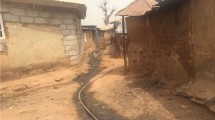Abstract
In and after times of war the pressure to rebuild as fast as possible is enormous. Research shows that during such pressure, qualities in housing and public spaces that acknowledge symbolic value, including social interactions and different levels of memories, are often overlooked. However, during a war it is not only houses and buildings that are destroyed, but also public and private spaces, places with memories and invisible networks. To (re-)create resilient places, it is essential to look at the different identities of places. This article argues that place-identity is essential in relation to building resilient communities since places can enhance and empower people to adapt and recover from adversity. According to a. o. Jacobs places get meaning by social interactions enabling new connections and experiences, as well as reflecting on and making space for collective and individual memories. In post-war rebuilding a sense of identity, local knowledge, social interaction and past experiences are even more urgent as demonstrated by Bakarat and others. Based on these findings a proposal is done to use the following leading notions in urban planning processes for post-war areas: memory—individual and collective—sense of safety and control and sense of belonging. One cannot just take out one aspect: it is the constant interaction between these three aspects that constitutes the sense of place-identity. As such these notions can be used as a tool in rebuilding practices for new emerging, different identities that are locally embedded, nationally and internationally supported.
Access this chapter
Tax calculation will be finalised at checkout
Purchases are for personal use only
Similar content being viewed by others
Notes
- 1.
- 2.
Draft Law No. 5655 “On Amendments to Certain Legislative Acts of Ukraine on Reforming the Sphere of Urban Development”.
- 3.
References
Alexander C, Silverstein M, Angel S, Ishikawa S, Abrams D (1975) The Oregon experiment. Oxford University Press, New York
Ascherson N (2005) Cultural destruction by war and its impact on group identities in Cultural heritage in Postwar recovery cultural heritage in Postwar recovery papers from the ICCROM FORUM held on October 4–6, 2005
Barakat S (2003) Housing reconstruction after conflict and disaster. Humanitarian Practice Network ODI, London
Barakat S (2005) Postwar reconstruction and the recovery of cultural heritage: critical lessons from the last fifteen years. Cultural heritage in Postwar recovery papers from the ICCROM FORUM held on October 4–6, 2005
Barakat S, Milton S (2020) Localisation across the humanitarian-development-peace nexus. J Peacebuild Dev 15(2):147–163
Bevan R (2006) The destruction of memory: architecture at war. In: Reaktion books, 2nd edn
Bourdieu P (1977) Outline of a theory of practice. English language edn. Cambridge University Press
Calogero P (2008) Kabul secure city, public city. Supplement to vol 15
de Solà-Morales M (2008) A matter of things. NAI Publishers
de Waal M (2012) De Stad als Interface. Digitale Media en Stedelijke openbaarheid. Universiteit van Groningen
Foucault M (1994) The order of things. An archeology of the human sciences. Vintage books edn
Haapala A (2003) The urban identity: the city as a place to dwell. In:Sarapik V, Tüür K (eds) Place and location III. Estonian Academy of Arts, pp 13–24
Haas T (2004) Reconstruction planning in the post-conflict zones. Bosnia & Herzegovina and the international community. Royal Institute of technology Tigran.pdf
Jacobs J (1961) The death and life of great American cities. Edition 1992. Vintage Books
Lefebvre H (1991) The production of space. English translation. Blackwell Publishing
Lewicka M (2019) On the essentialism of places: between conservative and progressive meanings. J Environ Psychol 65:101318; Elsevier 2019, pp 1–14
Lofland LH (1998) The Public Realm Exploring the City's quintessential Social territory. Transactions Publishers
Lynch K (1960) The image of the city. MIT Press
Mačkić A (2017) Maak steden na de oorlog weer een plek voor iedereen. Blauwe Kamer, pp 20–24
Preston PW (1997) Political/cultural identity, citizens and nations in a global era. SAGE Publications, London
Qazimi S (2014) Sense of place and place identity. Euro J Soc Sci Edu Res 1(1):306–310
Seamon D (2012) Place, place identity, and phenomenology: a triadic interpretation based on J. G. Bennett’s systematics. In: The role of place identity in the perception, understanding, and design of built environments. Bentham Science, pp 3–21
Soja EW (1996) Thirdspace Journeys to Los Angeles and other real-and- imagined places. Blackwell Publishing
Stanley-Price N (2005) The thread of continuity: cultural heritage in post-war recovery. Cultural heritage in Postwar recovery papers from the ICCROM FORUM held on October 4–6
Tuan, Y-F (1977) Space and place: the perspective of experience. Eight Printing 2001. University of Minnesota Press
Schaik, Marjo van (2018) Spaces of culture, new cultural venues in Amsterdam. Research and strategies. NAI010
van Schaik M (2022) Plea for a radical change of cultural venues. iccpr2022.hybr.live
Author information
Authors and Affiliations
Corresponding author
Editor information
Editors and Affiliations
Rights and permissions
Copyright information
© 2023 The Author(s), under exclusive license to Springer Nature Switzerland AG
About this paper
Cite this paper
van Schaik, M. (2023). Place-Identity and Post-war Rebuilding. In: Rubbo, A., Du, J., Thomsen, M.R., Tamke, M. (eds) Design for Resilient Communities. UIA 2023. Sustainable Development Goals Series. Springer, Cham. https://doi.org/10.1007/978-3-031-36640-6_7
Download citation
DOI: https://doi.org/10.1007/978-3-031-36640-6_7
Published:
Publisher Name: Springer, Cham
Print ISBN: 978-3-031-36639-0
Online ISBN: 978-3-031-36640-6
eBook Packages: Earth and Environmental ScienceEarth and Environmental Science (R0)




